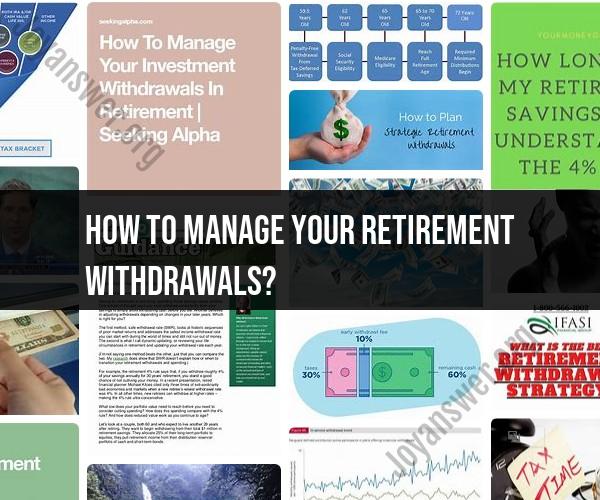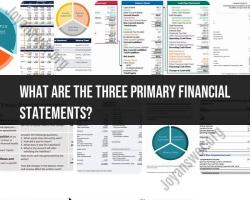How to manage your retirement withdrawals?
Managing retirement withdrawals is a crucial aspect of financial planning for your retirement years. Properly managing your withdrawals ensures that you can sustain your lifestyle throughout retirement without running out of money. Here are some financial planning tips for managing retirement withdrawals:
Create a Retirement Budget:
- Start by creating a detailed retirement budget that outlines your expected expenses during retirement. Include essentials like housing, healthcare, food, and transportation, as well as discretionary spending for leisure and travel.
Determine a Safe Withdrawal Rate:
- Calculate a safe withdrawal rate based on your retirement savings and expected lifespan. The 4% rule is a common guideline, suggesting that you can withdraw 4% of your initial retirement portfolio balance each year adjusted for inflation. However, consider consulting a financial advisor for a personalized approach.
Consider Social Security and Pension Income:
- Take into account any Social Security benefits or pension income you'll receive during retirement. These income sources can reduce the amount you need to withdraw from your savings.
Asset Allocation:
- Maintain a diversified investment portfolio that aligns with your risk tolerance and retirement goals. Balancing risk and return can help your portfolio grow while minimizing the impact of market fluctuations.
Tax-Efficient Withdrawal Strategies:
- Develop tax-efficient withdrawal strategies. Consider withdrawing from tax-advantaged accounts like Traditional IRAs and 401(k)s strategically to minimize your tax liability.
Emergency Fund:
- Maintain an emergency fund in retirement. Having a cash cushion can prevent you from having to sell investments during market downturns to cover unexpected expenses.
Dynamic Adjustments:
- Be prepared to adjust your withdrawal rate and spending as needed. In some years, you may need to withdraw more, while in others, you may be able to withdraw less. Flexibility is key.
Healthcare Costs:
- Account for healthcare costs, including insurance premiums, deductibles, and out-of-pocket expenses. Healthcare costs tend to increase with age, so plan accordingly.
Long-Term Care Insurance:
- Consider long-term care insurance to protect your retirement savings from the potentially significant costs associated with extended medical care.
Legacy Planning:
- If leaving a financial legacy is important to you, factor this into your withdrawal strategy. Work with an estate planning attorney to create an estate plan that aligns with your goals.
Regular Financial Check-Ins:
- Schedule regular financial check-ins with a financial advisor to review your retirement plan, assess your portfolio's performance, and make necessary adjustments.
RMDs (Required Minimum Distributions):
- Be aware of and comply with RMD rules if you have Traditional IRAs or employer-sponsored retirement accounts. Failure to take RMDs can result in penalties.
Considerations for Inflation:
- Account for inflation when planning your retirement withdrawals. What seems like a comfortable income today may not be sufficient in the future due to rising costs.
Consult a Financial Advisor:
- Seek guidance from a certified financial planner or retirement specialist. They can help you create a retirement income plan tailored to your specific circumstances.
Stay Informed:
- Keep up to date with changes in tax laws, Social Security rules, and retirement planning strategies. Staying informed can help you make informed decisions.
Remember that managing retirement withdrawals is an ongoing process. It's essential to adapt your strategy as your financial situation, goals, and the economic landscape evolve. Regularly reviewing and adjusting your retirement plan will help ensure your financial security throughout your retirement years.
A Guide to Effective Retirement Withdrawal Management
Retirement withdrawal management is the process of planning and managing how you will withdraw money from your retirement savings accounts during retirement. It is an important part of retirement planning, as it can help you to ensure that you have enough money to live comfortably throughout your retirement years.
There are a number of factors to consider when developing a retirement withdrawal strategy, including:
- Your age: Younger retirees may need to withdraw a lower percentage of their savings each year than older retirees, as they have more time for their savings to grow.
- Your health: If you have health problems, you may need to withdraw more money from your savings each year to cover medical expenses.
- Your lifestyle: If you have a high-cost lifestyle, you will need to withdraw more money from your savings each year than if you have a frugal lifestyle.
- Your income: If you have other sources of income in retirement, such as Social Security or a pension, you will need to withdraw less money from your savings each year.
Strategies for Safely and Efficiently Managing Retirement Withdrawals
There are a number of strategies that you can use to safely and efficiently manage your retirement withdrawals. Some of the most common strategies include:
- The 4% rule: The 4% rule is a simple rule of thumb that suggests that you can withdraw 4% of your retirement savings in the first year of retirement and then adjust that amount for inflation each year. This strategy is generally considered to be safe, but it is important to note that it is just a guideline and may not be appropriate for everyone.
- The bucket strategy: The bucket strategy divides your retirement savings into three buckets: a short-term bucket, a medium-term bucket, and a long-term bucket. The short-term bucket contains money that you plan to spend in the next few years. The medium-term bucket contains money that you plan to spend in the next 5-10 years. The long-term bucket contains money that you plan to spend in the next 10+ years. This strategy can help you to minimize your risk of running out of money in retirement.
- Dynamic withdrawals: Dynamic withdrawals involve adjusting your withdrawal rate each year based on your financial situation and market conditions. This strategy can be more complex than other strategies, but it can help you to optimize your withdrawals and reduce your risk of running out of money in retirement.
Navigating Your Financial Future: Retirement Withdrawal Planning
Retirement withdrawal planning is an important part of securing your financial future. By taking the time to develop a retirement withdrawal strategy, you can ensure that you have enough money to live comfortably throughout your retirement years.
If you are unsure how to develop a retirement withdrawal strategy, it is advisable to consult with a financial advisor. A financial advisor can help you to assess your financial situation and develop a strategy that is right for you.
Here are some additional tips for navigating your financial future through retirement withdrawal planning:
- Start planning early. The earlier you start planning for retirement withdrawals, the more time you will have to save and invest.
- Be realistic about your needs. When developing your withdrawal strategy, be realistic about how much money you will need to live comfortably in retirement.
- Review your strategy regularly. Your financial situation and market conditions can change over time, so it is important to review your withdrawal strategy regularly and make adjustments as needed.
- Be flexible. If your financial situation changes or if there is a market downturn, be prepared to adjust your withdrawal strategy.
By following these tips, you can develop a retirement withdrawal strategy that will help you to navigate your financial future and live comfortably in retirement.













